Ten best of Rhinoceros Horn Carvings from The Edward and Franklin Chow Collection
An extremely rare large rhinoceros horn archaistic guang vessel by You Yiliang. 17th century. Photo Sotheby's
masterfully carved in the form of an archaistic bronze guang vessel with a body of flaring rectangular section set with a channelled spout opposite a 'D'-shaped handle, the body finely carved in low relief with a wide register of taotie masks on a leiwen ground, supported on a tall foot of square section similarly decorated, the austere form interrupted by five playful chilong carved in reticulated high relief, nimbly clambering on the rim, handle and beneath the spout, the base with a four-character mark of the carver You Yiliang (You Yiliang zuo, 'Made by You Yiliang'), the horn of rich amber patina, wood stand; width 18.5 cm., 7 1/4 in. Estimate 12,000,000—15,000,000 HKD. Lot Sold 18,580,000 HKD (2,382,051 USD) to an Asian Trade
PROVENANCE: Collections of Edward T. Chow (purchased in Hong Kong, 1966) and Franklin Chow.
EXHIBITED: One Man's Taste. Treasures from the Lakeside Pavilion, Galleries of the Baur Collection, Geneva, 1988, cat. no. R18.
Craving for Carvings: Rhinoceros Horn from the Chow Collection, Asian Civilizations Museum, Singapore, 2003, cat. no. fc18.
LITERATURE AND REFERENCES: Jan Chapman, The Art of Rhinoceros Horn Carving in China, London, 1999. pl. 158.
Thomas Fok, Connoisseurship of Rhinoceros Horn Carving in China, Hong Kong, 1999, pl. 28.
NOTE: This cup belongs to a well known group of rhinoceros horn vessels fashioned in the form of the archaic bronze guang. Although a number of related examples are known from important museums and private collections, the present cup stands out for its impressive large size and for bearing the carver's mark in seal script You Yiliang zuo (Made by You Yiliang) on its base. This is the only carving known by You Yiliang, who worked in the 17th century (See Chapman, op.cit., p. 140). It is also unusual to find chilong carved below the spout of the vessel, making this example unique amongst cups of this type.
Edward Chow in his notes praises the workmanship and the quality of the material which he describes as touming hupo se ('translucent amber colour') and concludes with the words : xuyao baoer cang zhi ye ('to be kept and treasured').
Archaistic forms and decorative motifs were favoured by the nobility who were keen collectors of ancient artefacts. The fashion of archaism in the Song dynasty resulted in the production of pattern manuals and books which were widely copied. Carvers and artists were able to transfer the ritual heritage of bronze forms to mediums such as rhinoceros horn, ceramics and jade.
For related guang form cups see four examples, from the Qing Court collection and still in Beijing, illustrated in The Palace Museum Collection of Elite Carvings, Beijing, 2004, pls. 216-219; and another of closely related shape and decoration but lacking the chilong below the spout, published in The Complete Collection of Treasures of the Palace Museum. Bamboo, Wood, Ivory and Rhinoceros Horn Carvings, Shanghai, 2001, pl. 134, similarly bearing the carver's mark on the base in seal script that reads Hu Xingyue zuo ('made by Hu Xingyue'). Compare also a cup in the Chester Beatty Library, Dublin, included in Jan Chapman, 'The Chester Beatty Collection of Chinese Carved Rhinoceros Horn Cups', Arts of Asia, May-June 1982, p. 83, pl. 23; and another sold at Christie's London, 16th April 1985, lot 354, with a band of taotie and leiwen below a keyfret border on the exterior and with two chilong clutching and peering over the rim above a double bracket handle, closely related to that seen on this vessel
A rare and exceptionally carved rhinoceros horn libation cup, by Xing Cheng. Ming dynasty, dated to 1639. Photo Sotheby's
the gently flaring sides intricately carved in various levels of relief around the exterior, depicting on one side with two figures in a boat navigating down a swift river, a thatched fence and a brick wall on either side of the riverbank, and lofty trees, the reverse with two further figures upstream passing thatched huts and jagged cliffs, along one promontory a scholar and his attendant view the riverscape, inscribed to one side with Jimao xiari Moling Xing Cheng zhi ('Made by Xing Cheng of Moling on a summer day in the jimao year' corresponding to 1639), the interior carved with a reticulated high-relief pine tree growing from the side, the horn of rich chestnut tone; width 17.5 cm., 6 7/8 in. Estimate 8,000,000—12,000,000 HKD. Lot Sold 14,100,000 HKD (1,807,692 USD) to Mr Robert Chang
PROVENANCE: John Sparks, London, 1959.
Collections of Edward T. Chow and Franklin Chow.
EXHIBITED: One Man's Taste. Treasures from the Lakeside Pavilion, Galleries of the Baur Collection, Geneva, 1988, cat. no. R5.
Craving for Carvings: Rhinoceros Horn from the Chow Collection, Asian Civilizations Museum, Singapore, 2003, cat. no. fc5.
LITERATURE AND REFERENCES: Jan Chapman, The Art of Rhinoceros Horn Carving in China, London, 1999. pl. 153.
Thomas Fok, Connoisseurship of Rhinoceros Horn Carving in China, Hong Kong, 1999, pl. 145.
NOTE: Amongst rhinoceros horn carvings, those bearing an inscription are rare, but even more exceptional, and of invaluable historical importance, are those that provide the carver's name as well as a date of when the vessel was made. The nine-character inscription rendered on the face of a rock on the present vessel reads and may be translated as follows:
Jimao xiari Moling Xing Cheng zhi.
'Made by Xing Cheng of Moling on a summer day in the jimao year (corresponding to 1639)'.
This inscription records the carver's name, Xing Cheng, and dates the vessel to 1639. It also provides an additional information: the place name 'Moling' which may be interpreted as the location where Xing Cheng worked and where the vessel was produced or the town where Xing Cheng came from. Moling was the name used for present day Nanjing during the Ming and Qing dynasties.
Although no other carving signed by Xing Cheng appears to be recorded, it is suggested that he was possibly a pupil of the 17th century master carver Zhou Wenshu, a native of Moling (See Chapman, op.cit., p. 138). Edward Chow in his notes on this cup remarks that the vessel is in the style of Zhou Wenshu. He further mentions that the best rhinoceros horn carvers at the time came from Moling. Zhou's habit of incising an inscription on a rock surface near the lip of the cup, as seen on another vessel from the collection of Franklin Chow and illustrated in Fok, op.cit., pl. 130, is repeated here. In fact, the script used for the inscription on the two cups is identical.
For examples of carvings by Zhou see a cup decorated with a rocky landscape and pine trees, the rock face of the cliff incised in seal script with the three characters Wenshu zhi (made by Wenshu), from the collection of Harvard University Art Museums, included in Fok, ibid., pl. 131. Another vessel, in the Chester Beatty Library, Dublin, carved with a landscape and signed and dated by Zhou, is published in Jan Chapman, 'The Chester Beatty Collection of Chinese Carved Rhinoceros Horn Cups', Arts of Asia, May-June 1982, p. 78, pl. 16.
Artisans and craftsmen in China rarely signed their work unless they were commissioned to do so or felt that it was amongst, or indeed, their very best. While the inscription makes this vessel special, it is beautifully carved and a masterpiece in its own right. Edward Chow started his rhinoceros horn collection with this cup which he purchased from the renowned London dealer John Sparks in 1959. It was the exceptional workmanship, described by him as jingsu you li (extremely fine and forceful) that caught his eye. The landscape, inspired by the idyllic setting on the southern bank of the Yangtze River in Hubei province known as Chibi (Red Cliff) and made memorable by the Song poet, Su Dongpo (1037-1101), in his work titled Chibi fu (Ode on the Red Cliff), is skilfully rendered. Xing Cheng has treated his material as if painting on a hand-scroll - the rich landscape unfolds to the viewer as the cup is turned. Worked in high relief, the rock formations and trees appear three-dimensional. In fact, the rhinoceros horn is an ideal material for using carving and cutting techniques that best reproduce the natural likeness of the myriad indentations and the uneven surface of the stunning cliffs of Chibi. Chow remarked that he was shen xing shen wei ('extremely honoured and delighted' to own this cup.
For rhinoceros horn carvings depicting the landscape of Chibi see one in the collection of His Majesty King Gustaf VI Adolf of Sweden, included in Bo Gyllensvard, 'Two Yuan silver cups and their importance for dating of some carvings in wood and rhinoceros horn', The Museum of Far Eastern Antiquities. Bulletin No. 43, Stockholm, 1971, pl. 7; and another illustrated in The Complete Collection of Treasures of the Palace Museum. Bamboo, Wood, Ivory and Rhinoceros Horn Carvings, Shanghai, 2001, pl. 128, attributed to the late Ming dynasty. See also a cup from the collection of Thomas Fok, published in Fok, op.cit., pl. 162, and later sold at Christie's Hong Kong, 31st May 2010, lot 1818.
A figural landscape rhinoceros horn libation cup. Qing dynasty, 17th-18th century. Photo Sotheby's
the tall horn carved on the exterior with a continuous landscape with three figures in front of a walled compound along the banks of a turbulent body of water looking at a dragon on the opposite side, the opposite bank with trees and small huts all partially concealed by wispy clouds, one end of the horn set with a openwork handle formed by the trunk of a pine tree and the body of a climbing dragon twisting his way through the cliffs and clouds and breaking through to the interior of the cup, the horn of auburn tone ; width 15 cm., 6 in. Estimate 800,000—1,200,000 HKD. Lot Sold 8,420,000 HKD (1,079,487 USD) to an Asian Private
PROVENANCE: Collection of Franklin Chow (purchased in Munich, 1978).
NOTE: Although rhinoceros horn cups decorated with figures in a landscape are readily found, the present vessel is distinctive for its carving of a large, ferocious scaly dragon forming the handle. The combination of figural landscape and dragon motif makes this vessel unique with no other similar example recorded. The huge mythical animal is depicted climbing up the side of the cup and is peering over the lip. In the continuous landscape scene of rocks, water, trees, pavilions seen through swirling clouds there are three figures: a young boy accompanied by two elderly gentlemen both pointing to the dragon. The dragon in this design is a reference to the well known story of the old dragon teaching its young (canglong jiaozi); a story that came to represent the elderly official teaching his son how to succeed him and his wish for his boy to carry on his official position for generations to come.
Acquired in 1978, this cup was Franklin Chow's first addition to the Chow collection of horn carvings. The carving is meticulously executed, even the base is fashioned after the surface of a rock. The dragon brings a sense of surprise and vitality to the modelling which is imbued with elegance. The carver has skilfully undertaken the technical challenge of weaving the body of the dragon in and out between the pine tree and the clouds. It is an exceptionally fine cup with a charming subject matter – perhaps made as a gift from father to son.
Large scaly dragons are commonly depicted amongst waves, a reference to one passing the civil service examination when the carp, swimming upstream, transforms into a dragon. For examples of carvings with the 'dragon and wave' design see a cup with a vigorous scaly dragon carved as the handle, in the collection of the Chester Beatty Library, Dublin, included in Jan Chapman, The Art of Rhinoceros Horn Carving in China, London, 1999. pl. 234. Another vessel depicting a dragon weaving in and out of a pine tree trunk, not dissimilar to that seen on this piece, in the collection of Dora Wong, is also published ibid., pl. 235.
For examples of vessels decorated with a figural landscape see four illustrated in The Complete Collection of Treasures of the Palace Museum. Bamboo, Wood, Ivory and Rhinoceros Horn Carvings, Shanghai, 2001, pls 145-148, from the Qing Court collection and all attributed to the early Qing period.
A very rare 'grape vine' rhinoceros horn libation cup, signed Zi Zhen. 17th century. Photo Sotheby's
the broad shallow cup formed by a furled grape leaf, finely carved on the exterior in high relief with plump grapes growing from vines and curling tendrils extending down from the sides, the handle formed by gnarled twisted vines, all resting on a bed of grapes forming the foot, the interior incised with the fine veins of the leaf, signed on the exterior in low relief Zi Zhen, the horn of rich auburn tone; width 19 cm., 7 1/2 in. Estimate 6,000,000—8,000,000 HKD. Lot Sold 8,420,000 HKD (1,079,407 USD) to an Asian Private
PROVENANCE: Sotheby's New York, 10/11th April 1986, lot 294.
Collection of Franklin Chow.
LITERATURE AND REFERENCES: Thomas Fok, Connoisseurship of Rhinoceros Horn Carving in China, Hong Kong, 1999, pl. 107.
NOTE: The two-character inscription in seal script, stet between grape vines on the front, reads Zi Zhen. Bao Yanli, Deputy Director and Research Associate at the Shanghai Museum believes that the inscription was made by the carver. It may be the carver's name or his style name (zi). Although there is no record of Zi Zhen, a lotus form washer carved with a single crab, in the Shanghai Museum, bears the same two character signature.
This magnificent piece, fashioned as a large grape leaf with finely rendered veins and richly laden with large succulent grapes is a quirky example of a small group of rhinoceros horn carvings decorated with the fruit design. The cup is elegantly shaped and expertly fashioned; even the lip of the vessel is frilled in the form of a grape leaf with the fruit rendered in high relief bulging over the exterior of the surface. The exceptional quality and size of the material is also noteworthy.
The fruiting grapevine as a subject was especially popular in the Ming dynasty, and was frequently painted on early Ming blue and white wares such as the dish recovered from the waste heaps of the Ming Imperial kilns at Jingdezhen included in the exhibition Imperial Hongwu and Yongle Porcelain Excavated at Jingdezhen, Chang Foundation, Taipei, 1996, pl. 44. Grapes are also depicted with squirrels forming a popular motif that represent the wish for many children and ceaseless generations of sons and grandsons (songshu putao).
For related pieces, see a rhinoceros horn cup decorated with grape branches, leaves and fruit, in the Staatliches Museum für Völkerkunde, Munich, illustrated in Jan Chapman, The Art of Rhinoceros Horn Carving in China, London, 1999. pl. 222; another in the Chester Beatty Library, Dublin, illustrated in Jan Chapman, 'Rhinoceros Horn Carvings and their Buffalo Horn Imitations', Orientations, January 1988, p. 41, fig.1; and a third example carved with the 'Grape and Squirrel' theme, included in the exhibition One Man's Taste. Treasures from the Lakeside Pavilion, Galleries of the Baur Collection, Geneva, 1988, cat. no. R13, from the collection of Edward Chow. Two cups decorated with grapes, from the Qing Court collection and still in Beijing, are published in The Complete Collection of Treasures of the Palace Museum. Bamboo, Wood, Ivory and Rhinoceros Horn Carvings, Shanghai, 2001, pls.114 and 130, the latter made by using a whole horn. Compare also a grape vine cup in the Victoria and Albert Museum, London, published in Craig Clunas, Chinese Carving, London, 1996, fig. 35; one sold at Christie's New York, 22nd March 2007, lot 154; and one from the Estate of Cyrus Jasperse, sold in our New York rooms, 13th June 1979, lot 133.
A large rhinoceros horn libation cup with cranes. 17th century. Photo Sotheby's
finely carved on the exterior with tall crane standing beneath a lofty pine along the banks of a turbulent sea with waves crashing over rocks, the reverse with a second crane swooping down over the water before jagged cliffs, the openwork handle formed by the trunks of a pine tree and peach tree, the branches all intertwined with hanging vines extending over the mouth and on to the interior, with further lingzhi and orchids springing out from the sides of the cliffs, all set between wispy clouds around the mouth and swirling waves on the base, the horn of chocolate-brown tone and a smooth patina; width 20.1 cm., 7 7/8 in. Estimate 1,800,000—2,500,000 HKD; Lot Sold 7,220,000 HKD (925641 USD) to an Mr Robert Chang
PROVENANCE: Spink & Son, London, 1978.
Collections of Edward T. Chow and Franklin Chow.
LITERATURE AND REFERENCES: Thomas Fok, Connoisseurship of Rhinoceros Horn Carving in China, Hong Kong, 1999, pl. 144.
NOTE: This finely modelled and exquisitely rendered cup is full of auspicious symbolism. Cranes are generally associated with Shou Lao, the God of Immortality, who is often depicted riding on the back of a crane. The vigorously modelled pine tree that rises to the rim of the vessel also symbolizes longevity, as the pine is evergreen and is known to live for a long time. The design further includes the lingzhi fungus with the auspicious herb lancao growing on the cliff, all representing the wish for an eternal life. There is also a seasonal reference to spring through the flower – orchid – seen depicted below the spout. Cups of this design were made as birthday gifts or for special celebratory occasions. The vessel is also special for its magnificent size, being one of the largest in the collection.
A cup decorated in low relief with a pair of cranes, parrots and phoenix, against a rocky background, in the Chester Beatty Library, Dublin, is illustrated in Jan Chapman, The Art of Rhinoceros Horn Carving in China, London, 1999, pl. 253. See another cup sold at Christie's New York, 19th September 2007, lot 3, carved with two cranes, one standing and one soaring in the air.
The animated and high-crested waves around the base are reminiscent of those carved on a lotus form vessel, the lower portion of the body decorated with a dragon emerging from highly stylized tumultuous waves, from the collection of Dr. Ip Yee, included in 'Chinese Rhinoceros Horn Carvings', International Asian Antiques Fair, Hong Kong, 1982, pl. 25. Another cup decorated with waves and bats, from the Qing Court collection and still in Beijing, is published in The Complete Collection of Treasures of the Palace Museum. Bamboo, Wood, Ivory and Rhinoceros Horn Carvings, Shanghai, 2001, pl. 149.
A 'Lotus leaf and Dragons' rhinoceros horn libation cup. 17th century. Photo Sotheby's
the amber and black-toned broad shallow cup carved in the form of a furled lotus leaf with fine veins, resting on a short curled stem, further carved with five playful high-relief chilong clambering along the interior and exterior, two of the dragons forming the openwork handle on one side, the head of one peeking over the rim coming face to face with a smaller dragon on the interior, inscribed on the interior with Boya Shiling jingke ('Shiling respectfully presents "Boya" [this cup] to his guests'), the patina smoothly polished; width 19.3 cm., 7 5/8 in. Estimate 1,500,000—2,000,000 HKD. Lot Sold 6,620,000 HKD cAnonymous
PROVENANCE: Christie's London, 8th April 1981, lot 19.
Collection of Franklin Chow (purchased in Switzerland, 1985).
EXHIBITED: Craving for Carvings: Rhinoceros Horn from the Chow Collection, Asian Civilizations Museum, Singapore, 2003, cat. no. fc61.
LITERATURE AND REFERENCES: Jan Chapman, The Art of Rhinoceros Horn Carving in China, London, 1999. pl. 126.
Thomas Fok, Connoisseurship of Rhinoceros Horn Carving in China, Hong Kong, 1999, pl. 24.
NOTE: In the form of a curled lotus leaf with distinct veins inside and out, this cup is exquisite for its pleasing form, finely carved chilong decoration and the high level of finish, noticeable especially on the base, that reflect the carver's attention to every detail. The vessel bears a six-character inscription which runs parallel to the lip edge on the interior. It reads and may be translated as follows:
Bo Ya shiling jingke.
Shiling respectfully presents "Boya" [this cup] to his guests.
It is possible that Shiling is the owner's name and that Boya is the name of the cup.
The handle of this cup is fashioned in the form of a large chilong clutching the mouth of the rim. Its modelling is imbued with elegance and vitality. A number of smaller chilong can be found on both the interior and exterior of the vessel, all expertly fashioned to appear lively and spirited and bringing strength and movement to the vessel.
While this cup stands out for its large size, its base is especially noteworthy. The stalk of the lotus leaf is made into a ring forming a foot for the cup. Chapman, ibid., pp. 94-95, illustrates a cup in the Museum voor Volkenkunde, Rotterdam, pl. 83, that also uses the stems of the lotus plant to provide the base and the handle.
Chilong can be found on a lotus-leaf form cup, in the collection of Thomas Fok, illustrated in Fok, op.cit., pl. 3; on another sold in our London rooms, 13th July 2005, lot 104; and on a cup sold in our New York rooms, 30th March 2006, lot 132.
A 'Lotus leaf and Chilong' rhinoceros horn libation cup. 17th century. Photo Sotheby's
the dark amber-coloured horn carved in the form of a finely veined furled lotus leaf with one large dragon and five smaller chilong clambering around the vessel on the interior and exterior, the playful dragons all carved in high relief and openwork depicted in various contorted positions, the largest dragon forming the handle beneath a smaller lotus pad on the rim while two peer over the rim at a smaller dragon on the interior, the exterior further set with a small snail slithering down the side, all supported on a band of waves crashing against the foot, the surface with a smooth patina; width 19 cm., 7 1/2 in. Estimate 3,000,000—5,000,000 HKD. Lot Sold 6,620,000 HKD (848718 USD) to an Asian Trade
PROVENANCE: Sotheby's Hong Kong, 20th November 1985, lot 269.
Collection of Franklin Chow.
NOTE: This cup features an unusually wide mouth, rich translucent honey-tone colouration and fine carving of numerous entwined large and small chilong on the body and under the lip. The strong veining of the lotus leaf, which is carried out on both the interior and the exterior of the vessel is also worth noting. While the design is well known from vessels of this type, the carver has added an original and humorous touch to his work: a small climbing snail placed just below the spout. While the chilong represent action, as do the waves depicted with a prominent spume around the base, the snail brings a sense of natural calmness.
The chilong is possibly one of the most important and widely used animals in the horn carvers' repertoire. They are most frequently depicted on carvings in the archaistic style; for example see a cup in the Chester Beatty Library, Dublin, illustrated in Jan Chapman, The Art of Rhinoceros Horn Carving in China, London, 1999. p. 178, pl. 234, where the author notes the importance of dragons in animal carvings. The dragon represents the emperor himself, but also acts as the beneficent 'bringer of rain' (Chapman, ibid., p. 178).
For lotus leaf form vessels carved with chilong see one from the collection of Thomas Fok included in Thomas Fok, Connoisseurship of Rhinoceros Horn Carving in China, Hong Kong, 1999, p. 50, pl. 3, where the author notes that this type of decorative style is reminiscent of the jade waterpots of the Southern Song dynasty. The Fok cup was subsequently sold at Christie's Hong Kong, 27th May 2008, lot 1718. Another related lotus leaf form cup carved in low relief with chilong, the base in the form of a well-defined whirlpool and the handle carved with a dragon, from the collection of Dr. Ip Yee, is illustrated in Dr. Ip Yee, 'Chinese Rhinoceros Horn Carvings', International Asian Antiques Fair, Hong Kong, 1982, p. 33, pl. 24. See further two cups sold in our London rooms, 13th May 2009, lot 75, and 13th June 2005, lot 104; and one sold at Christie's London, 7th November 2006, lot 48.
A rhinoceros horn libation cup with hawks. Qing dynasty, 18th century. Photo Sotheby's
the maroon coloured conical horn carved as a pine tree trunk with two high-relief birds on the back of the horn, one hawk standing on a pine branch, the second bird depicted in flight with wings outstretched and feet drawn towards the body set at the rim, the gnarled pine branches wrapped around the trunk and extending over the rim onto the interior, the surface further lightly carved with patches of pine bark; width 16 cm., 6 1/4 in. Estimate 1,500,000—2,500,000 HKD. Lot Sold 5,420,000 HKD (649872 ,USD) to an Asian Private
PROVENANCE: Spink & Son, London, 1978.
Collections of Edward T. Chow and Franklin Chow.
EXHIBITED: One Man's Taste. Treasures from the Lakeside Pavilion, Galleries of the Baur Collection, Geneva, 1988, cat. no. R15.
Craving for Carvings: Rhinoceros Horn from the Chow Collection, Asian Civilizations Museum, Singapore, 2003, cat. no. fc15.
LITERATURE AND REFERENCES: Thomas Fok, Connoisseurship of Rhinoceros Horn Carving in China, Hong Kong, 1999, pl. 169.
NOTE: The carving of this vessel is especially fine with the two hawks strategically placed to take advantage of the material's organic form and fibrous inclusions. The natural groove running down the long curve of the horn is particularly deep. The pair of hawks are described by Edward Chow in his notes as you li ('strong'). The artist has successfully transferred the image of the hawk, well known from Tang dynasty mural paintings, into a three-dimensional composition. See a Tang painting depicting a hunting scene, from the west mural in the second tunnel of the tomb of Prince Yide in Qian, Shaanxi province, illustrated in Sekai bijutsu taizenshu: Toyo hen, vol. 4, Tokyo, 1997, p. 31.
Bird of prey such as hawks and eagles (ying) represent the hero in Chinese art as its name is homophonous with the character for hero (yingxiong). A flying hawk conveys the wish for attaining a journey of ten thousand miles (pengcheng wanli) and the wish for a long and successful career.
Rhinoceros horn vessels bearing the design of birds are rare, although a cup deeply carved with a bird of prey, possibly a hawk, swooping down against a background of waves, in the Chester Beatty collection is included in Jan Chapman, 'The Chester Beatty Collection of Chinese Carved Rhinoceros Horn Cups', Arts of Asia, May-June 1982, p. 78, fig. 13. Another cup, carved with a richly plumed hawk perched on one of the branches while, on the opposite side, another swoops down in flight, was offered in our New York rooms, 30th March 2006, lot 135. A third example depicting a pair of doves, flying above jagged rockwork, was sold in our London rooms, 13th July 2005, lot 108.
See also a cup carved with a design of mandarin duck and lotus, bearing the seal of the late Ming period master carver You Kan, formerly in the collection of Dr. Ip Yee and now in the Palace Museum, Beijing, illustrated in The Complete Collection of Treasures of the Palace Museum. Bamboo, Wood, Ivory and Rhinoceros Horn Carvings, Shanghai, 2001, pl. 127.
A ‘Pine And Mapie’ Rhinoceros Horn Libation Cup, Qing Dynasty, Kangxi Period. Photo Sotheby's
the conical horn of auburn tone and a smooth patina, carved with a handle to one side formed by the reticulated trunks of a pine tree and a dead tree trunk wrapped with hanging vines, their branches extending around the side of the vessel, set opposite a small waterfall and an arched bridge between two cliffs, the sides further carved with lush maple trees growing on the banks, the interior left plain, the foot inscribed in relief in xingshu (running script) with a six-character poem zai hu shan shui zhi jian ('It is all between the mountains and steams'; width 14 cm., 5 1/2 in. Estimate 700,000—900,000 HKD? Lot Sold 5,060,000 HKD (648,718 USD) to an Asian Private
PROVENANCE: Sotheby's Hong Kong, 20th May 1986, 174.
Collection of Franklin Chow.
EXHIBITED: Craving for Carvings: Rhinoceros Horn from the Chow Collection, Asian Civilizations Museum, Singapore, 2003, cat. no. fc56.
NOTE: The exceptional quality of the carving of this cup continues with the beautiful calligraphy written in xingshu script on the base. It reads and may be translated as follows:
Zai hu shan shui zhi jian.
It is all between the mountains and the streams.
This famous quote is from the work of the Northern Song dynasty statesman, historian, writer and poet Ouyang Xiu (1007-1072) titled Zui Weng Ting Ji (The Record of the Pavilion of the Old Drunkard). Ouyang wrote this essay in 1046 when he was appointed taishou (Grand Warden) at Chuzhou in Anhui province. In it he describes the picturesque and natural beauty of Chuzhou and portrays the simple life of its peasant folk. However, Ouyang was bitterly disappointed and frustrated at being sent there as he felt that his talent was not recognized. In Chuzhou he spent his days drinking and became famous for entertaining his guests and getting drunk in a pavilion built by a Buddhist priest, which he named Zui Weng Ting (Pavilion of the Old Drunkard) after himself.
The superb carving of this cup is reminiscent of the work of the master carver Zhou Wenshu. The whole exterior is modelled as a cliff face with the roots of several pine trees emerging from crevices in the rock. The handle is fashioned in the form of two pines whose main branches stretch over the sides of the cup and are festooned with vines. For examples of carvings by Zhou see a cup decorated with a rocky landscape and pine trees, the rock face of the cliff incised in seal script with the three characters Wenshu zhi (made by Wenshu), from the collection of Harvard University Art Museums, included in Fok, ibid., pl. 131. Another vessel, in the Chester Beatty Library, Dublin, carved with a landscape and signed and dated by Zhou, is published in Jan Chapman, 'The Chester Beatty Collection of Chinese Carved Rhinoceros Horn Cups', Arts of Asia, May-June 1982, p. 78, pl. 16.
Compare also a cup from the collection of Kenyon V. Painter, Cleveland, carved with pine, paulownia and flowering trees scattered across mountain cliffs and high rocks, sold in our New York rooms, 19th March 2007, lot 380; and another, from the Estate of Nils Nessim, Stockholm, sold at Christie's New York, 25th March 2010, lot 819, depicting trees amidst rock formations. A third cup carved in high relief with a tree-strewn landscape, the handle formed by the stout branches
A Reticulated Stem ‘Lotus Leaf’ Rhinoceros Horn Libation Cup. l7th Century. Photo Sotheby's
the highly polished amber and black coloured conically shaped horn carved in the form of a furled lotus leaf forming the cup, with subtle veining on both the interior and exterior, wrapped on the exterior with high-relief lotus flowers, with further lotus leaves and reeds all issuing from long thin intertwining reticulated stalks tapering to a point, the base detailed with the small holes of cut stalks, the rim of the interior set with a water weed and a small floret to one end, wooden stand; height 17 cm., 6 3/4 in. Estimate 900,000—1,200,000 HKD. Lot Sold 4,820,000 HKD (617,949 USD) to an Asian Private
PROVENANCE: Collections of Edward T. Chow (purchased in London, 1968) and Franklin Chow.
EXHIBITED: One Man's Taste. Treasures from the Lakeside Pavilion, Galleries of the Baur Collection, Geneva, 1988, cat. no. R12.
Craving for Carvings: Rhinoceros Horn from the Chow Collection, Asian Civilizations Museum, Singapore, 2003, cat. no. fc12.
LITERATURE AND REFERENCES: Thomas Fok, Connoisseurship of Rhinoceros Horn Carving in China, Hong Kong, 1999, pl. 96.
NOTE: This cup belongs to the well known group of vessels in the form of a large lotus leaf with buds, blossoms and smaller leaves born on slender long stalks. It is carved in openwork that shows the original conical shape of the material. The craftsman has skilfully made use of the entire length of the horn with the solid tip transformed into the stems of the plant. Jan Chapman in The Art of Rhinoceros Horn Carving in China, London, 1999, pp. 72-73, notes that the hollow cavity of an Asian horn is the natural shape of a leaf, and both the inner and outer surfaces can be engraved to show the typical vein markings.
Purchased in 1968, Edward Chow describes this cup as shengdong ziran ('lyrical and picturesque') with the foliage rendered in a vivid and naturalistic fashion. He further notes that the carver has made the vessel with great care and has produced a masterpiece.
The inspiration for cups of this type may have come from one of the earliest carvings known from the Qing Court collection, which also uses the entire horn: a cup in the form of a mallow-flower, attributed to the early Ming dynasty and illustrated in The Complete Collection of Treasures of the Palace Museum. Bamboo, Wood, Ivory and Rhinoceros Horn Carvings, Shanghai, 2001, pl. 109.
For related lotus leaf cups where the original shape of the horn has been skilfully preserved see one, in the collection of Mr. Michel de Selys Longchamps, included in Fok, op.cit., pl. 95; and another, in the collection of Dora Wang, exhibited at the Sackler Museum in Washington D.C. and illustrated in the World Journal (Shijie Zhou Kan), no. 852, 2000, p. 12. Compare also two fine cups of this type sold in our London rooms, 31st October 1986, lot 175, and 27th October 1989, lot 186.
Whole horns were also used for making a completely different type of vessel. They were fashioned to represent a large lotus leaf with a long stalk, but by bending the tip of the horn upward a sprout was created for a water dropper. For examples of water droppers, see one published in The Complete Collection of Treasures of the Palace Museum. Bamboo, Wood, Ivory and Rhinoceros Horn Carvings, op.cit., pl. 115; another included in The Palace Museum Collection of Elite Carvings, Beijing, 2004, pl. 207; and a third from the collection of Arthur M. Sackler, illustrated in Fok, op.cit., pl. 100, together with a cup in the Shanghai Museum, pl. 101.
A ‘Lotus Leaf’ Rhinoceros Horn Libation Cup, l7th Century. Photo Sotheby's
the well-polished horn of chestnut tone, carved in low relief around the exterior of the shallow wide-mouth cup with the fine veins of a furled lotus leaf, enveloped by two thin reeds, the openwork handle on one side with three intertwining stalks tied together by the tips of the reeds and extending to the base, resting on two small lotus bud feet, the interior left plain save for the subtle wavy contours imitating a leaf's natural shape, wooden stand; width 15 cm., 5 7/8 in. Estimate ,200,000—1,500,000 HKD. Lot Sold 4,820,000 HKD (617,949 USD) to an Asian Private
PROVENANCE: Collections of Edward T. Chow (purchased in Hong Kong, 1972) and Franklin Chow.
EXHIBITED: Craving for Carvings: Rhinoceros Horn from the Chow Collection, Asian Civilizations Museum, Singapore, 2003, cat. no. fc11.
NOTE: This cup is a superb example of what is possibly one of the most popular decorative themes in the rhinoceros horn carver's repertoire – the lotus leaf and flower. While it displays characteristic elements seen on cups of this design, such as the veining on the exterior of the leaf, the lotus stems and buds, this vessel stands out for the unusual fashioning of its foot which is in the form of three entwining stalks. The carver has created an openwork design by binding the stalks together with the millet grass. While stalks are frequently made into a ring-base for the vessel, this carver has created an original design. Nature was also on the forefront of the carver's mind when rendering the veins of the leaf which he has outlined in low relief rather than simply incising them.
The millet grass that binds the lotus leaf and the stems is important for a number of reasons; it gives the design a sense of strength; and the combination of the lotus leaf and millet grass together form the visual pun hehe (harmony) that expresses the wish for 'living in harmony year after year'. The lotus itself is the symbol of purity and uncontaminated beauty, and is associated with the pure and virtuous character of the gentry and scholar-literati.
Edward Chow in his notes describes the cup as keai ji zhi ('beautiful and adorable') and praises the skills of the carver for producing a delicate piece which he found unusual for its time. He also mentions that the cup is 'in the style of Cheng and Hong (you Cheng Hong zuo feng)'. Cheng Hong represents the period between the Chenghua and Hongzhi reigns of the Ming dynasty, suggesting a strong Ming period influence on the decoration.
Although no other similar example appears to be recorded, a cup from the Murray bequest and now in the Victoria and Albert Museum, London, illustrated in Craig Clunas, Chinese Carving, London, 1996, fig. 31, uses two intertwining stems to form the base that extend upwards to become the handle of the vessel. Another related cup is published in Dr. Ip Yee, 'Notes on a collection of Chinese rhinoceros horn carvings', International Asian Antiques Fair, Hong Kong, 1982, p. 35, pl. 28; and a third, in the form of a large lotus leaf carved with the lotus stalks and millet grass tied together by a ribbon, from the collection of Thomas Fok, is included in Thomas Fok, Connoisseurship of Rhinoceros Horn Carving in China, Hong Kong, 1999, pl. 97.
Sotheby's. Rhinoceros Horn Carvings from the Edward and Franklin Chow Collection. 08 Apr 11. Hong Kong www.sothebys.com

/https%3A%2F%2Fprofilepics.canalblog.com%2Fprofilepics%2F1%2F0%2F100183.jpg)




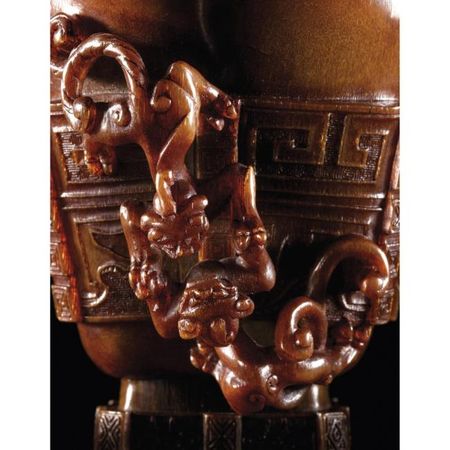

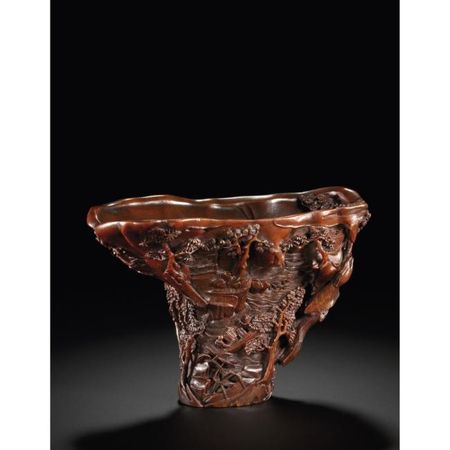

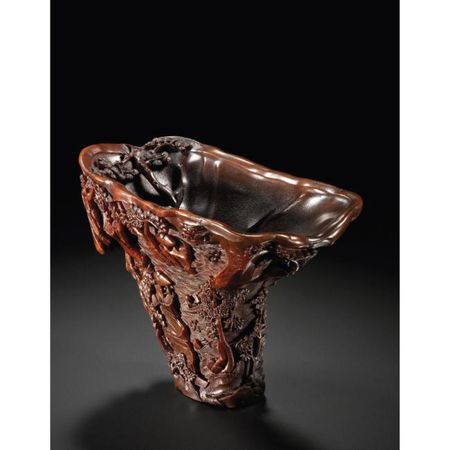


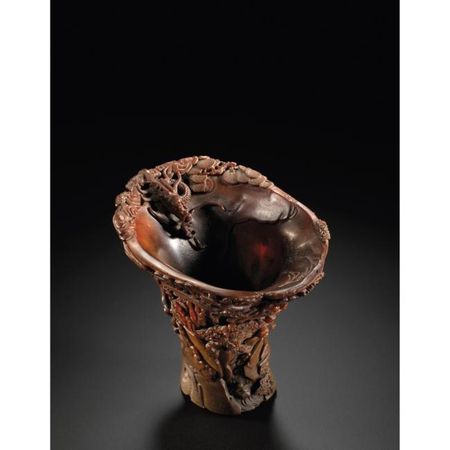










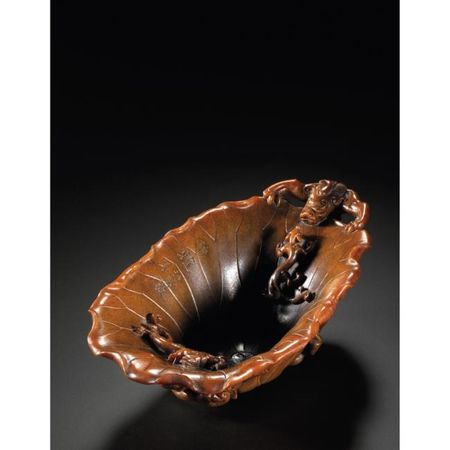



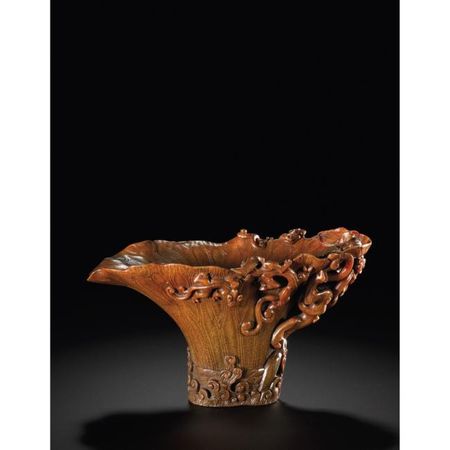







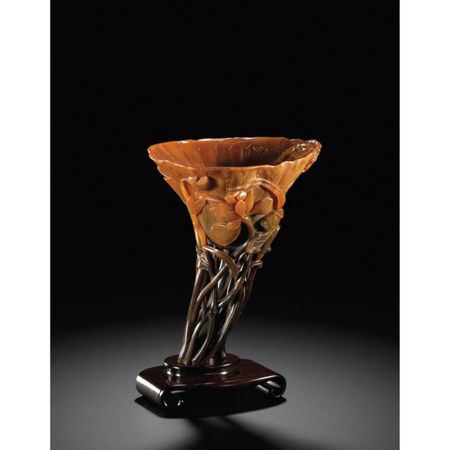







/http%3A%2F%2Fstorage.canalblog.com%2F34%2F01%2F577050%2F66379918_o.jpg)
/http%3A%2F%2Fstorage.canalblog.com%2F04%2F00%2F119589%2F66268897_p.jpg)
/http%3A%2F%2Fstorage.canalblog.com%2F05%2F37%2F119589%2F66268549_p.jpg)
/http%3A%2F%2Fstorage.canalblog.com%2F86%2F30%2F119589%2F66187962_p.jpg)